
Louisville’s Commerce Threatened
CSI Welcomes New Directors
Canal Notes #6 — The Arch
Canal Stock Certificates
Creative Signage For Covington
Louisville’s Commerce Threatened
In 1846 canals and railroads were being built in the eastern United States. A reporter for the
Evansville Journal encouraged Evansville citizens to take note and develop further marketing
plans so as not to be eclipsed by other cities. Indiana’s completed and planned improvements
and those at Cincinnati, Ohio, were threatening to take away Louisville’s opportunities for
business. That city, at the Falls of the Ohio, seemed to be losing markets to other cities on the
Ohio River according to the Louisville Courier.
The Evansville Journal of March 12, 1846 carried the following article:
READ. The Louisville Courier is trying to wake up the citizens of that sleepy city to exertion
for its future advancement and improvement, and the article we copy below, although not
intended to stimulate us to action, may, nevertheless, profitably engage the attention of the
people of this section. It must not be supposed that because we have succeeded in obtaining a
grant of lands from Congress to complete our [Wabash & Erie] Canal, and made an
arrangement with our bondholders to finish it in four years, that we can now rest from our
labors—that there is nothing else to be done. We have now only commenced in the race, and
unless we continue we had just as well not made the start. Evansville is destined to be THE
great city of Indiana, and second to none on the Ohio river, but it cannot be this without the
exertions of its citizens to make it so. The apathy of our people, shown on every occasion where
the improvement and growth of the place is contemplated—their refusal to attend the public
meetings which are called upon important occasions and for important ends—this little
inclination they have to subscribe a few dimes, although by so doing they might greatly benefit
themselves and their neighbors,—all this must give way to a more liberal feeling—to greater
industry and activity. We must be ever watchful of our interests and anxious to further them at
ANY cost. If we do our duty, the fears expressed by our Louisville friends that Evansville
within a few short years sweep ahead of them will be realized, and we shall stand among the
first of the great cities of the West.
The Louisville Courier carried the following article that was reprinted by the Evansville
Journal:

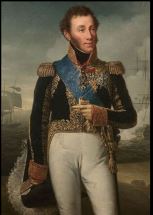
When George Canning, then prime minister of Great Britain (1827), found that the Bourbon dynasty of France had joined the other legitimates of the continent in the principle of “armed George Canning Duc d’Augouleme intervention,’ and a French army under the command of the Duc d’Augouleme had invaded Spain, under the pretense of “pacification,” to reduce the country again under absolute control of another branch of the Bourbons, he directed the acknowledgement of the independence of the late South American province of Spain, and then under extension of British power in the East Indies this policy was assailed in Parliament, for supinely permitting the aggrandizement of France and Spain. He replied in these memorable terms, to show the far-reaching policy of the British empire:
“Was it necessary that we should blockade Cadiz? No. I looked another way; I resolve that if France had Spain, it should not be Spain with the Indies—I called the new world into existence to redress the balance of the old.”
Similar in emulation, though more honorable in rivalry and more beneficial and truly ennobling in object and results, are the efforts of kingdoms, states, or even small communities, the equal or exact their neighbors in growth, prosperity, and means of happiness—to call a new world of business into existence to redeem the balance of the old.
In 1773, Louisville was located by Col. Thomas Bullitt, Sen., but its occupation being abandoned, in 1780 it was laid out and settlements commenced under a charter from Virginia. In 1800 it numbered 600 inhabitants; in 1810, 1,300.
Cincinnati was first laid out in 1780, but so little was the future growth of the place anticipated, that Judge Symmes, the original proprietor of the land, never selected it as the site for a city, and located his expected metropolis 14 miles lower down, near the mouth of the Miami, now only known by North Bend, the residence of the late Gen. Harrison, his son-in-law. In 1800, the site of the future “Queen of the West; was only known as Fort Washington, from a log fort on the river bank, and the late commander-in-chief of the army, then a lieutenant stationed at the post, usually drilled the small garrison, on the first bank west of what is now Broadway, and south of Third St., then covered with a stately forest, now in the heart of the city. In 1802 Cincinnati was incorporated, and in 1805 the population amounted to 750. Now, the population numbers 99,000, while Louisville has less then 40,000. Canals, railroad, and water power have been brought to that metropolis, and the trade of the lakes and east is opened by the Miami Canal, and the travel and transportation to and from central Ohio and the seaboard, will soon be secured by the Sandusky and Miami Railroad and the branch to Columbus.
Eastern Indiana pays tribute to the persevering enterprise of Cincinnati. The Whitewater Canal, like the Madison road, was the work of Indiana. Its terminus was at Lawrenceburg. The citizens of Cincinnati, by seizing the advantages furnished by it, with no narrow State restrictions on their enterprise, connected that canal with the Ohio at Cincinnati, and now the Lawrenceburg terminus is forgotten. The trade goes to the great depot of the region of country.—By this canal, they reach the National Road at Cambridge City in Indiana.
A charter has been lately granted for a branch from the Madison road to Milford in Decatur county, Indiana. A few miles more will reach the old line of the Lawrenceburg and Indianapolis railway, and some 30 miles more the White Water Canal. Either will be made tributary to the metropolis of Cincinnati. The “Queen City of the West” will then lay her truncheon of command over the trade of Central Indiana and point her scepter to the Lakes and mines of the Northwest.
In four years the Wabash and Erie Canal will be completed to Evansville. Then Cincinnati, Madison and Evansville, with Toledo on Lake Erie, and Michigan City on Lake Michigan, will divide the trade of Indiana.—The broken grounds and knobs of the counties of Clark and Scott, Washington and Floyd may yet remain for the oldest metropolis of the Ohio Valley.
Meantime, on the southern border of our State [Kentucky], our neighbors of Nashville and Knoxville are “up and doing.” With steadfast purpose to bring the valley of the Tennessee and Cumberland to the Ocean Market, and to concentrated depots of trade at their own homes, they traversed the route of the Tennessee and Hiwasee branch from Knoxville to reach the Georgia and Carolina roads, with a connecting railway now graded, for the trade and business of East Tennessee, and from Nashville push their determined enterprise to Chattanooga on the extremity of Georgia, to connect with the Atlantic and Western Rail Road, now reaching the Oextenania in Cap county, near the north-western limit of the latter State. Two lines from Nashville to Memphis and Mills Point or Hickman, will leave Kentucky, except the narrow south-western border; isolated from the progress of improvement. Since the opening of the Miami Canal, Cincinnati has drained a portion of the trade of the Kentucky river, and frequently extended her purchases of wheat and other grains, to our neighbors on the Indiana shore. When Evansville has become the market, by the Canal, for the surplus of the Wabash, our trade with the Green river may be divested more or less to that depot.
Louisville and vicinity may thus slumber on in undisturbed isolation. The law of progress will not disturb her quiet, and the hum of active industry will soon cease to annoy her repose. When time may rouse her from this Rip Van Winkle sleep, age will have gathered gaunt wrinkles and profitless wisdom, while little remains but suffering exhaustion of Venice “to die daily.”
When Venice held the carrying trade to Alexandria and Asia Minor, wealth flowed into her coffers and her sails whitened the seas. Alexandria, also was worthy of the name of its founder. Both timed in wealth and neglected the opportunities to render their prosperity permanent. Had they combined to establish and facilitate the over-land trade from Europe to India by the Red Sea and Persian Gulf, sought to give security to trade and business, instead of oppression and strife; they might now be the keys of the Mediterranean and the East.—The adventurous enterprise of Vasco De Gama opened another route for the Indies and for a time the countrymen, the Portuguese, reaped the rich reward.
England has at length established an over-land travel and small traffic through Alexandria and
Egypt, but the channel of trade is forever diverted from Venice to Marseilles and other parts,
and the aid of foreign enterprise can scarcely galvanize the decrepitude of Egypt and Alexandria.
Other reasons remain to show the necessity for the citizens of Louisville to embark in this work,
from the improbability that such a charter and opportunity will be ever again offered by another
State to increase the wealth of the metropolis of this, and the positive inability of the small
towns and farming populations on the route to complete the work.
CSI Welcomes New Directors
The Canal Society of Indiana elected two new members to its board of directors at its annual
meting August 27, 2022 in Logansport. We welcome the following aboard:
Margaret Griffin
Margaret Griffin is a native Hoosier. She grew up in Angola, Indiana and lived in Huntington where she taught fifth grade for 25 years. Now retired, she and her husband, Lowell, live in Southwest Allen County near Fort Wayne. They have two grown daughters and five grandchildren who live in the Indianapolis area.
After retirement, she began volunteering at the Forks of the Wabash Historical Park in Huntington. She interprets in the Canal Room, presenting for school tours in the Spring and Fall. Margaret is the secretary of the Indiana Chapter of the Theodore Roosevelt Association and has written two books: The Amazing Bird Collection of Young Mr. Roosevelt about our 26th President’s boyhood; and Folks on the Home Front, about her grandparents during World War I. She is doing research for another nonfiction book about the Wabash and Erie Canal.
Dr. Ronald Morris
Dr. Ron Morris, a professor of history at Ball State University, has had his students develop a website for the Canal Society of Indiana as well as publish its news and journal “The Tumble” for the past few years and has been a strong supporter of the society. His other interests are hiking the Appalachian Trail, the Hoosier National Forest, and restoring historic homes.
His first home restoration was the James Reardon, 1830 Federal-style home in Centerville. In 2011 he purchased the long-neglected 1848 Greek Revival-style home of Indiana Governor Oliver P. Morton on the National Road in Centerville and completed its restoration in nine years. His current project is a doctor’s home in Rushville.
Ron’s teaching and research specialties at Ball State include elementary social studies, museum studies, community engagement and public history media.
He has written Bringing History to Life: First Person Presentations in Elementary and Middle School
Social Studies; The Field Trip Book: Study Travel Experience in Social Studies; and History and
Imagination: Reenactments for Elementary Social Studies. He is the co-author of 50 Social Studies
Strategies for K-8 Classrooms and has written over sixty articles on elementary social studies education.
He conducts curriculum and instruction teacher in service, etc. with programs designed to engage and challenge people to work together to find solutions for their elementary social studies students. Professional development from K-6 is flexible to meet school schedules. In 2004 and 2013 he led a Virginia B. Ball Center for Creative Inquiry seminar. The 2013 product was Crossroads Connect – Indiana’s first digital social studies textbook for fourth grade. A digital third grade social studies book expanded the scope of this project.
He has created curriculum materials for classroom use and cultural institutions including artifact kits, curriculum, document packets, and eight videos. Customized solutions for educational or cultural institutions are his specialty. The most recent video series was The World of George Rogers Clark. He has created media projects and museum exhibits for cultural institutions and historical societies like the topic of Yount’s Mill near Crawfordsville, Indiana, for the Carnegie Museum. He has created adaptive reuse reports such as the one for the Delaware County Historical Society Museum, and four video games. He has also created two phone apps such as The Battle of Perryville, and mobile experiences including both walking and driving tours of Carmel, and a tour of western Wayne County.
Canal Notes #6
“The Arch“
Tom Castaldi
There’s one piece of Wabash & Erie Canal history that’s best experienced when crossing over
— Burnett’s Creek Arch on the Towpath Road in Carroll County. It has served canal and road
travelers for over 150 continuous years.


Wabash & Erie Canal engineers crossed the stream by building a stone bridge that they called Culvert Number 100, thus enabling canal boats to pass along their way up and down the line. While there were other Wabash & Erie stone structures built in the 1840s, Burnett’s Creek Arch became a road bridge over the stream when the towpath ceased serving the canal. For decades the arch saw horse, buggy and wagon traffic yet even today cars, trucks, farm equipment and bicycles cross it daily.
All along the line many of the canal structures from Fort Wayne had been built of nearby timber and wood and were prone to decay when exposed to the elements. Suitable building stone was not found until the line cut through Georgetown Quarry a mere six miles up the line from Burnett’s Creek.
Well built from the start, it is 150-feet long and 15-feet high. A relic from Indiana’s canal days,
it has and continues to earn its keep handling traffic as it has since 1841. An historical sign
marks the site and a set of wooden steps leads down to the stream for a closer view of canal-era
stonemasonry.
You can pass over this piece of history at Burnett’s Creek, on the Towpath Road at Lockport,
Indiana. It’s on the north side of the Wabash River between Logansport and Delphi, through
some of the most beautiful scenery in the region. The old Towpath Road is totally different
country and most who visit fell the difference. It’s a piece of history to be passed over by
people who would do so to feel what difference 150+ years can make.
Canal Stock Certificates
Neil Sowards, CSI member from Fort Wayne, recently found the following examples of canal
stock certificates from other canals on E-bay. Sometimes canal bonds were called canal stock
during the canal era.
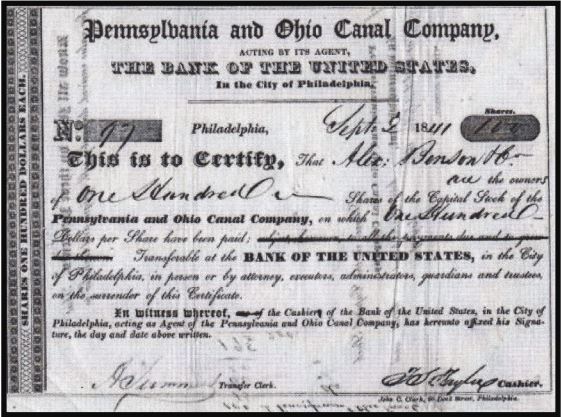
Pennsylvania and Ohio Canal Company, Pennsylvania, September 2,1841
This is an uncommon stock certificate Alex Benson 100 shares
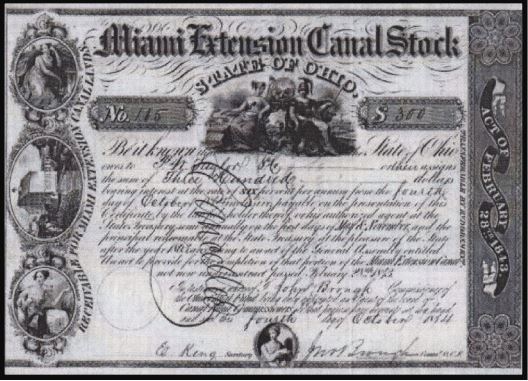
Miami Extension Canal Stock, Ohio, October 4, 1841
We would call this a bond. P.N. Taylor, $300
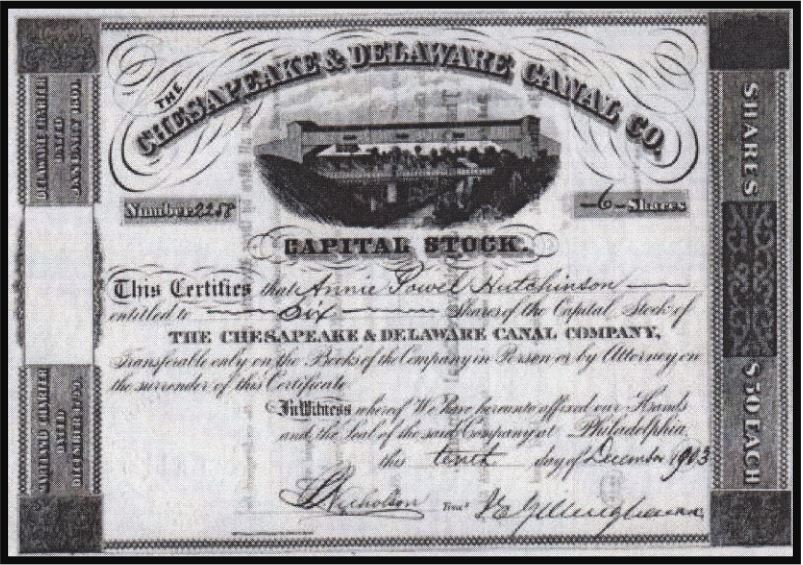
Chesapeake & Delaware Canal Co. issued December 10, 1903
Annie Powell Hutchinson, six shares

The president and clerk of the Blodget Canal Company of Amoskeig Falls in New Hampshire issued five thousand shares like this one No. 996, which was not dated.
Creative Signage For Covington
Terry Bodine, CSI director from Covington, Indiana, suggested that one of CSI’s markers be placed on Duane Grubb’s property located on River Road and the Wabash & Erie Canal about 2 miles south of Covington, Indiana. After receiving Duane’s permission to place a sign on his property, it was ordered and delivered to Terry for placement. Terry is very creative and made a canal boat to place above the sign when it was erected.
This should really attract the attention of passersby to the sign.
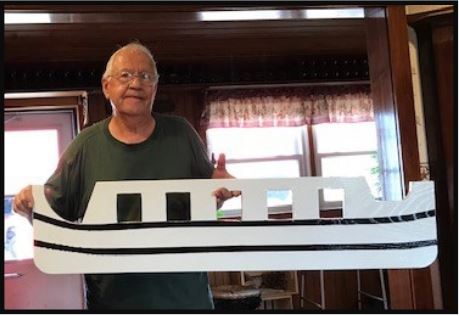
The sign was erected on July 31, 2022 by Terry, his son Don Bodine, grandson Clayton Bodine, and property owner Duane Grubb. The following pictures showing the sign being erected were taken by Duane’s wife, Pat Grubb.
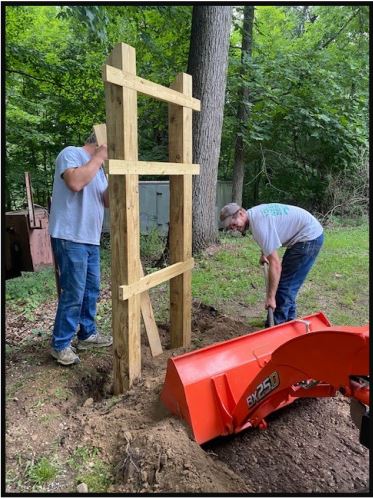

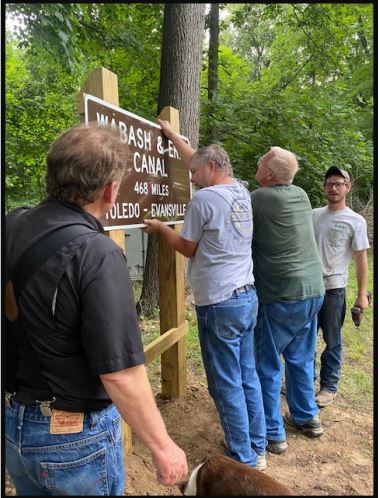
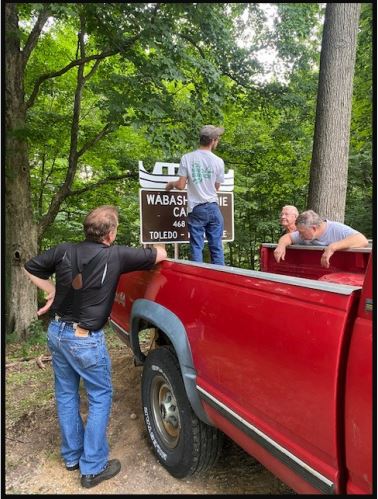
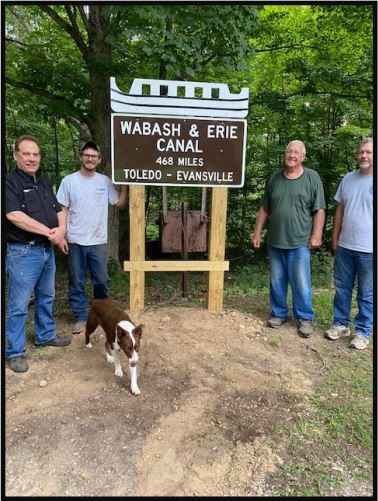
After the sign was erected, Clayton Bodine took pictures showing what remains on the Wabash & Erie Canal behind the sign.


The following day the Bodines returned to view the sign from a distance.

Another great sign to be proud of. Hip Hip Hooray!
News from Delphi
McCain Named Golden Hoosier

Dan McCain, Carroll County Wabash & Erie Canal Association president and CSI director was awarded this year’s Golden Hoosier Award on Monday September 26, 2022 at 1 p.m. in Indianapolis. The award is a collaboration between the office of Lieutenant Governor Suzanne Crouch and the Indiana FSSA. It is the highest honor bestowed upon a senior citizen of Indiana recognizing those who have devoted their lives and services to help fellow Hoosiers and improve their communities.
Since his retirement Dan has spent countless hours leading the community projects at Delphi’s Canal Park to fruition and volunteering at Canal Park. He not only obtained the grant which built the Conference and Interpretive Center, he helped build and maintain Delphi’s trail system. Recently he appeared in video productions that will preserve local history. Hip Hip Hooray!
Blue Bridge Gets New Deck
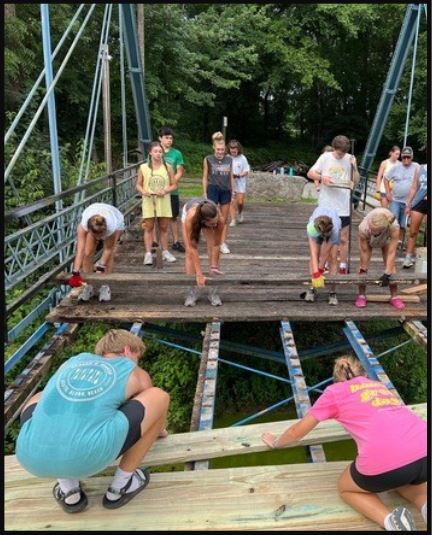
One of the latest examples of volunteerism at Canal Park in Delphi, is the re-planking for the deck of the Blue Bridge located near Pizza Hut on Bicycle Road. The aging planks needed to be replaced. The children of Richard and Marilyn Black donated funds to purchase new, pressure-treated lumber. Then the volunteers took over.
First the Monday-Wednesday-Friday crew from Canal Park prepared the bridge and made sure al the pieces were ready for swift removal. The “Campers in Leadership Training” from Camp Tecumseh took over removing the old decking and installing the new. This crew of teenagers completely finished the bridge in under three hours.
I & M Canal Volunteers Seek Information
During July a group of volunteers under the leadership of Arnie Bandstra from the Illinois and Michigan Canal in Ottawa, Illinois visited Canal Park to learn how the Delphi group created its facilities. They were hunting for ideas to develop the canal in their area. They were inspired by all that has been accomplished at Canal Park.
Kids’ Fun Day
Canal Park hosted “Kids’ Fun Day” on Saturday afternoon August 6, 2022. There were the usual attractions to see as well a special hands-on exhibits for kids. They saw how laundry was done in the 1800s and learned to string green beans for drying. There were craft stations for tin punch work and woven turtles. A bucket toss game was enjoyed by all ages.
Jones Finds Cleared Canal Bed

Troy Jones, CSI member from Clinton, Indiana, discovered this cleared section of the Wabash & Erie Canal
prism near Howard, Indiana. He will attempt to contact the owner to find our why it was cleared and perhaps
get permission to mark it with a CSI sign.
New Haven’s Canal Landing Park

Canal Landing is a 1/3rd acre pocket park on Broadway between Main and Bell Streets in New Haven, Indiana. Its historic plaque tells the importance of the Wabash & Erie Canal in New Haven’s development. From Moser Park, the canal traveled northeast along the north side of Main Street and through town to cross Green Street between Bell and Canal. It then followed the route of U.S. 24 East. The canal bed is very apparent on the south side of U.S. 24 driving east. CSI has placed a sign marking its route, which was shown in the September issue of “The Tumble.”
Town Named For Charles Butler
Craig Berndt, CSI member from Fort Wayne, recently found that his hometown was named for Charles Butler. He writes:

(1802 – 1897)
We don’t know why my hometown in DeKalb county was named Butler. The only pioneer in the county with that name lived 10 miles SE of Butler. Rumor has it that the town was named for David Butler by one of his descendants. Why name it for an unknown settler a dozen miles away instead of naming it for one of the town’s original settlers or other associated people?
While researching construction of the New York Central Railroad thru Butler, I found that Charles Butler was one of the directors of NYC’S predecessor during construction. Predecessors of NYC and the Eel River RR platted the Village of Butler in 1856. The RR didn’t know David Butler when they platted the village. The post office was named Jarvis after another RR director.
It was common to name new towns for directors, including Brimfield, IN, and Stryker, Oh, on NYC, and I’m confident that my hometown was named for Charles Butler. As we know, Charles Butler was the person most responsible for saving Indiana from financial failure due to canal debt. He also saved Michigan from failure for reasons I didn’t research.
For further information on Charles Butler and the Butler Bill see the July 2022 issue of “The Tumble.”
Canal Ball of 1846
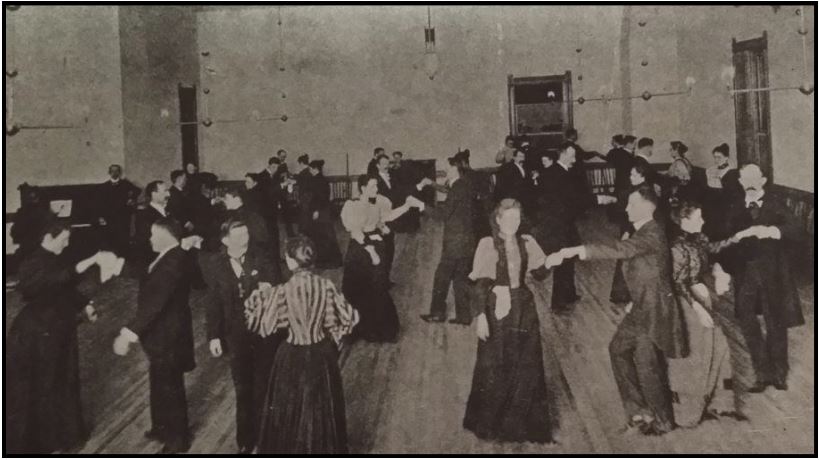
Whenever a portion of the Wabash & Erie Canal was completed or more work announced it was a
time for celebration. In 1846, when the Butler Bill was passed turning the completed and proposed
canal works over to the bondholders, a Canal Ball was held on Monday, February 23 at the Exchange
in Evansville. One of the terms of this bill required the completion of the canal to Evansville and her
citizens rejoiced. The local paper carried the announcement of the event and a short follow-up
description.
Evansville Journal, Evansville, Indiana
February 12, 1846
CANAL CELEBRATION.—Our friends at Evansville, we understand, are to have a great celebration
in honor of the passage of the Canal Bill, on Monday, the 23rd, inst. If they invite strangers, we shall
be on hand—Statesman.
Hold yourself in readiness, Burns, for the 23rd. You are invited and anxiously look for, on that day, by
more than one dark eyed nymph. Nerve yourself for the occasion.
Evansville Journal, Evansville, Indiana
February 12, 1846
CANAL BALL—23rd
.
Tickets of invitation to the Canal Ball on the 23rd. Inst. will be ready for delivery on Saturday morning next. Gentlemen intending to be present and wishing Tickets for their ladies are requested to call on the Managers,
Evansville Journal, Evansville, Indiana
February 26, 1846
THE BALL.— The Ball given at the Exchange on Monday last, in honor of the passage of the Canal
Bill, was truly a splendid affair. The company was the most numerous we ever recollect to have seen
collected together on the occasion of the kind. Great credit is due to Mr. Drew, the gentlemanly host
of the Exchange, for the very liberal manner in which he got up the whole affair and we are glad to
learn he bill be renumerated for his trouble. We have been promised a more lengthy account of the
Ball from one who had more opportunities of judging than ourself.
Puett’s Appointment Remembered
In July of 1847, the Wabash & Erie Canal was transferred from the State of Indiana to a Trust owned
by the bondholders. The Board of Trustees was composed of three directors. Two of these directors
were selected by the bondholders but the third was appointed by the Indiana Legislature. The chart
below lists these directors.
Jacob Hager of Terre Haute was appointed Chief Clerk and occupied this position from 1847 until the sale of the canal in 1876. Jesse Lynch Williams was appointed Chief Engineer. Some directors,
especially Austin M. Puett, were controversial in their actions regarding the canal.
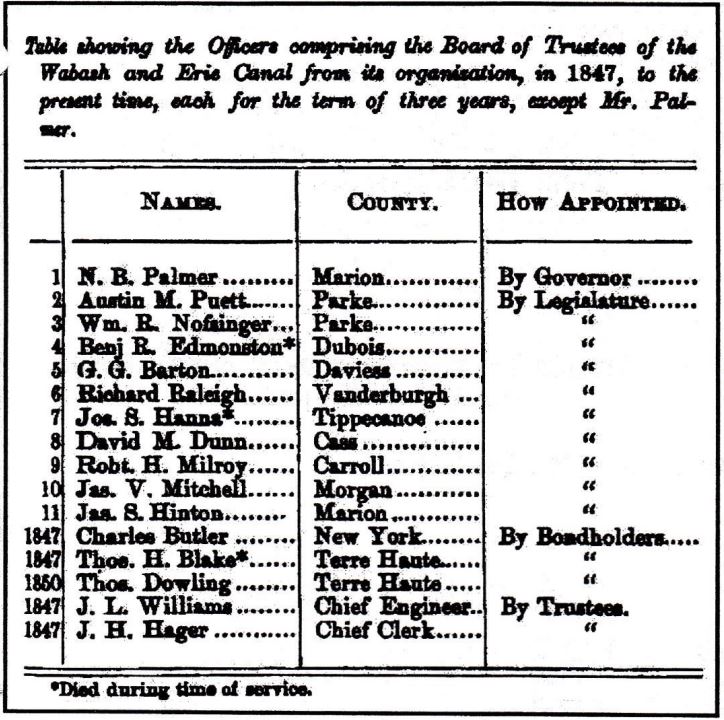
Canal trustees were appointed for 3 year terms. Austin Puett, who was nominated by Governor James Whitcomb and appointed a Trustee by the Indiana Legislature, was from Parke county, Indiana. He served in this capacity under Whitcomb for two terms (1847 and 1850) and then was appointed in 1855 by Joseph Albert Wright, Indiana’s tenth governor, to fill the remaining term of Benjamin Edmonston, who had died in office that year.
When Governor Wright was campaigning for another term in office in July of 1856, he was going to Evansville to speak and several articles in the Evansville Daily Journal on July 23 of that year encouraged everyone to welcome him with open arms. However, one article was sent to the paper encouraging just the opposite reception. It says Puett did not have the qualifications to serve as Trustee.
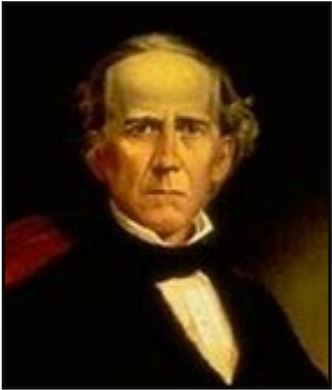
“An what a warm welcome he [Governor Wright] should receive from the citizens of this place! How
cordially we should receive the man who so recently betrayed our interests! Last August the city of
Evansville made a warm appeal to Gov. Wright, and asked of him a favor which was due us by all
sense of right and justice and good faith. There was a vacancy in the office of Canal Trustee.
Evansville asked, as the southern terminus of this canal [Wabash & Erie], that one of her citizens
should be appointed to the office. [Benjamin Edmonston of Jasper had just died on August 1, 1855]. Through the untiring exertion of her citizens, the donation of land was obtained by which the canal
was built from Terre Haute to this city. Our interests had been long jeopardized and neglected, and
we earnestly desired that the new Trustee should be from this place. Numerously signed petitions
were sent to Gov. Wright, and a large one in favor of a member of his own party. Gov. Wright had in
a speech here expressed a warm interest for Evansville, as he does for every place he speaks at, by the way. Justice, the interest of our city as well as of this section of the canal, demanded that the petitions of our citizens should be answered. But what was the result? Why, he appointed his own brother-in-law, Austin M. Puett, of Parke county, to this office—a man who had once before been long enough in the position to prove he was deficient in the proper qualifications for the office, and who had given general dissatisfaction. Our citizens felt outraged. Governor Wright’s own organ, edited by the same man who now controls it, abused him heartily for his course, and stigmatized him as a demagogue. And yet this editor, and the very men of his party who united with him in so bitterly condemning Gov. Wright, are now making their preparations to give this demagogue an enthusiastic reception this evening! Let the people of Evansville remember the Canal Trustee, and how their prayers were despised by the man they are now called upon to welcome. He does not come here as the Governor of the State, and he deserves no reception as such. He visits us as a vile office-seeker, deserting the duties of the office he is already disgracing to pander to the lowest passions and instincts of party as an Old Line stump speaker, to obtain another office. As such let him be treated. If he has no respect for himself nor for his position, we are not called upon to have any for him. His very public presence here after his treatment of us, is an insult to the community.”
When Governor James Whitcomb appointed Austin Puett a Trustee of the Wabash & Erie Canal, he
served with Charles Butler and Thomas H. Blake in 1848. The trustees changed from time to time. In
1850 Austin served with Charles Butler and Thomas Dowling. As trustee he participated in the
following canal lettings in 1848:
-Forty miles of the W & E extending from Terre Haute to Point Commerce including one reservoir, a
number of lift-locks, culverts, and rebuilding a portion of Eel river dam and the guard-lock located
there.
-Seventeen miles of the canal from Point Commerce to Newberry including 6 lift-locks, one guardlock, a dam across White river 12 feet in height and over 400 feet in length, and rock excavation at the Patoka Summit.
-Fifteen and a half miles of canal from Maysville to Petersburg including heavy earth work, the
aqueduct over East Fork of White river 400 feet in length.
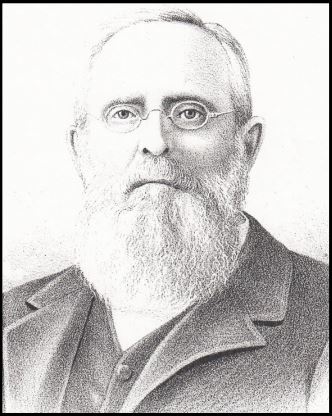
At the time Governor Wright was appointing a Canal Trustee to replace Edmonston, there were three
applicants for the office from Evansville: Dr. George B. Walker, James Rouquett and James G. Jones,
Esqs. According to an article in the Evansville Journal of 1856, “The two first the Governor could
have no kind of objection to. Mr. Jones, in view of his politics might have been objectionable, though
we are free to confess, we should have vastly preferred his appointment, to that of Austin M. Puett—
it cannot be denied that either of these gentlemen would have made an active, energetic and efficient
Trustee. As much cannot be said of Mr. Puett. He has filled the office of Trustee before, and it is
conceded that he was careless and incompetent. The only merit that he possesses consists in the fact
that he is the brother-in-law of Governor Wright.”
Winchell Locks Through Passau Locks
This September, while many CSI members were home mowing their grass or picking their tomatoes,
Linda Winchell, CSI life member from Indianapolis, took a wonderful trip on the Danube River. She
sent CSI headquarters the following photos of her cruise ship passing through the Passau Locks. She pointed out that no mules were used to pull the boat.
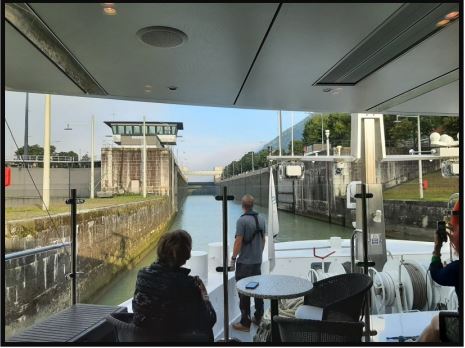
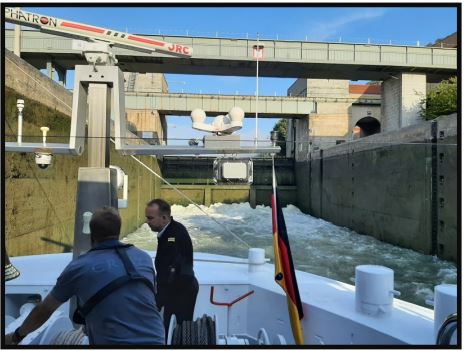
Canal Society of Indiana’s 40th Anniversary Celebration
By Sue Simerman
Photos Craig Berndt, Sue Jesse, Bob Schmidt, Sue Simerman, and Rich Voorhees
On the pleasant Saturday morning of August 27, 2022, twenty-nine attendees for CSI’s 40th
anniversary celebration and tour of the Wabash & Erie Canal in the Logansport area were
greeted with coffee and sweet treats at 9:30 am at the Cass County Historical Society at 421 E.
Broadway in Logansport. This building had been a Farmers and Merchants Bank and our
meeting room gave us an excellent view into the opened vault.
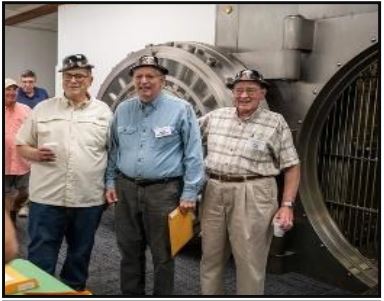
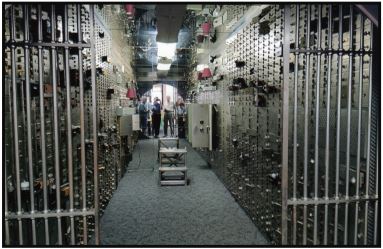
We began with our CSI meeting led by President Bob Schmidt. He introduced all attendees and
said we were lucky enough to have some new faces on this single day tour.
We were brought up to date on our signage program. The signs we purchase are less expensive
than the ones that the state places. We have some that still need to be placed and so far our
signs are holding up well. Our only disappointment is that our signs at the canal reservoirs in
southern Indiana have disappeared.
We held our board of directors election for those who were up for reelection for a three year
term with two new added members, which are Margaret Griffin and Dr. Ron Morris.
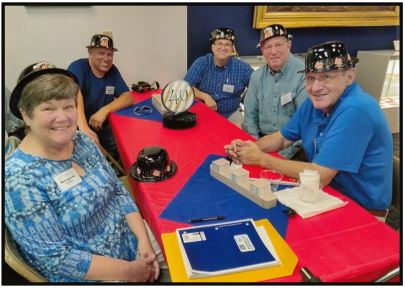

Margaret Griffin Dr. Ron Morris
We were saddened by the loss of board member Frank Timmers. He passed December 22,
2021.
Bob told of our CSI plans for 2023.
SPRING SYMPOSIUM – A one day event with a brown bag lunch. This will be held in Fort
Wayne on March 25.
FALL TOUR -September 15-16 We will visit Crawfordsville and see the General Lew Wallace Study and Museum. The tour will include going to Covington to see the Wabash and Erie Canal and signage provided by CSI. We will see a covered bridge or two and maybe take a miniature train ride. Terry Bodine, one of our board members, will be helping with this tour.
We had more discussion about feeder dams and dams where we have placed signage: Fort
Wayne, Huntington, Lagro, Peru and Pittsburg.
Tom Castaldi, our Logansport tour guide and local expert, explained our tour route for the car
caravan. Tom grew up in Logansport, is a CSI board member and on top of that he the Historian
for Allen county. He pointed out that Logansport has one way streets and road work being
done. His plans for our route had to be changed a little from what he had written in our tour
guide. The guide gave us travel directions, photos and notes of historical facts.
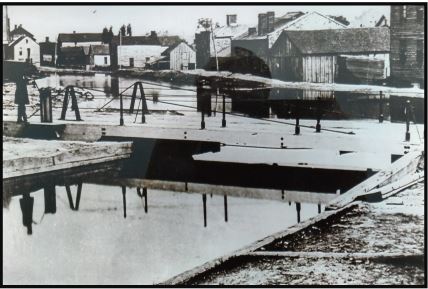
At the time of our tour the intersection of Erie Avenue and 5th Street was under construction. A
picture at the Historical Museum showed how the Wabash & Erie Canal (now Erie Avenue)
approached pivot bridge #33 and then proceeded north along what is now 5th Street to the
aqueduct.

Tom Castaldi talked about Aqueduct #5 our first stop where the Wabash and Erie Canal crossed the Eel River. The south abutment is in place and the remains of the five piers can be seen in the river. Tom took questions and explained why the canal crossed the Eel River.
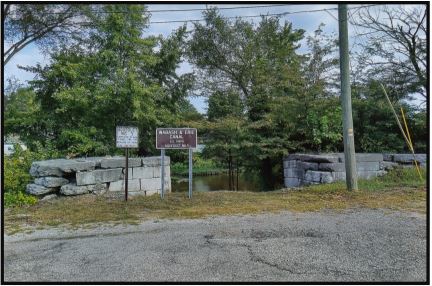
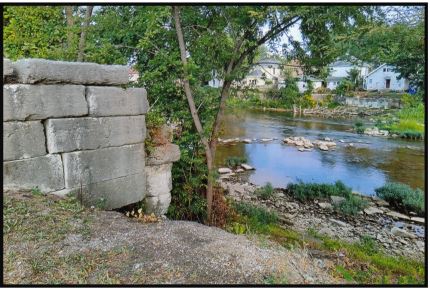
Rich Voorhees, a well known photographer, took a picture of our group at the aqueduct.

On the other side of the Eel River was the site of a large turn around canal basin. It is now
covered by homes.
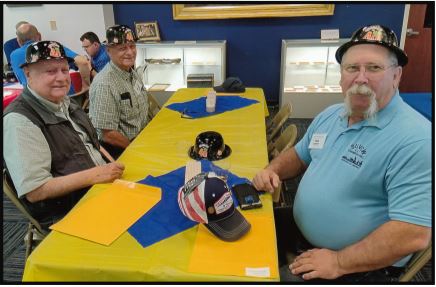
Our parade of cars followed the route of the canal. Near France Park we turned to follow the
Wabash River as best as we could. Tall foliage and areas of the canal have been filled in. We
entered France County Park, once the site of the Georgetown Quarry where much of the building stone was sourced for canal structures. We crossed the Wabash River at Georgetown and slowly enjoyed the river and the scenery. We approached the Logansport State Hospital that was founded in 1888, drove through the 280 acre complex and returned to the historical society on East Broadway for a catered lunch. Bob and Carolyn had placed 40 year celebration hats on our tables along with wooden canal boats.

After lunch, CSI member Craig Berndt of Fort Wayne, gave a slide presentation on his float trips on the Ohio River and many other rivers. He is very experienced with having been a frogman with the U.S. Navy. He educated us with new river terminology involving tows, barges and the dangers on the rivers. It was very well presented.
At this point of our day we could choose to use our own cars to continue the tour or leave. A short distance away we visited the old Cass Co. Historical Society Museum at 1004 E. Market
Street. There are some canal related items and many rooms to explore, one of which was the Castaldi grocery store exhibit.
We passed the home of Jordan Vigus at the corner of Broadway and 11th Street. Vigus broke ground for the Wabash & Erie Canal in Ft. Wayne in 1832 and was the first mayor of
Logansport in 1838.
The next stop was to ride the Dentzel Carousel at Riverside Park on the Eel River. The carousel
had been at Fort Wayne in Robison Park 1896 -1920. Robison Park was built at the St. Joe
Feeder Dam for the Wabash & Erie Canal. The carousel has been very well maintained.

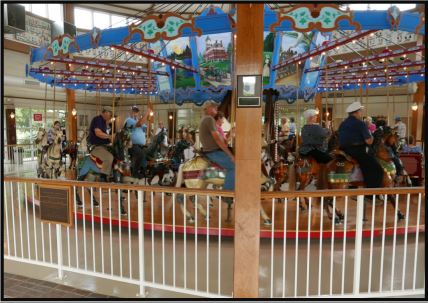
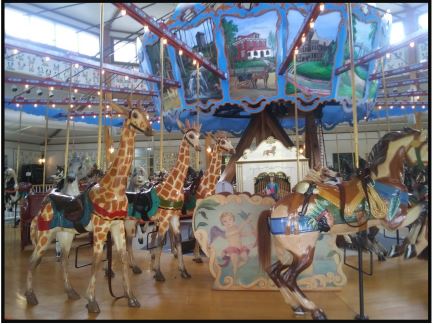
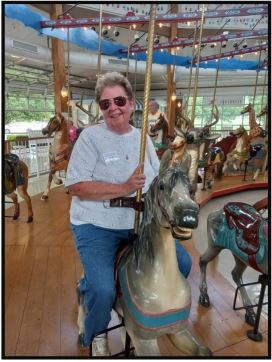
Driving east we passed the town of Lewisburg. On Old Stone Rd. we could see one of CSI’s signs for
“Prairie Creek Stone Arch #73” at the home of Mr. Dave Buffum. He was there to greet to us on his golf cart and willing to give rides to the stone arch. We all were impressed with it. As most canal artifacts, it is beginning to show signs of slippage and wear from rushing water in the creek.

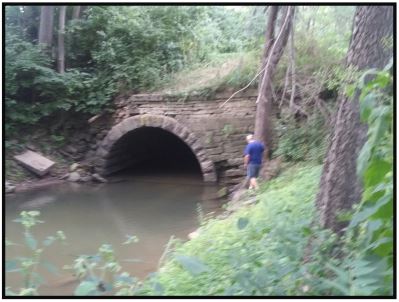
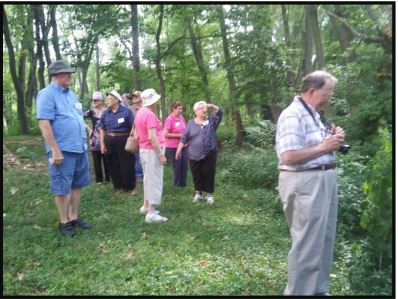
The caravan ended at Peru on Wayne St. to see where Dam No. 3 was built across the Wabash
River to feed water into the Wabash and Erie Canal. The sign for the dam placed by CSI was
removed when bridgework was done and still needs to be put back up.
Thank you to all who took part and prepared this educational day.
Sue Simerman
Secretary

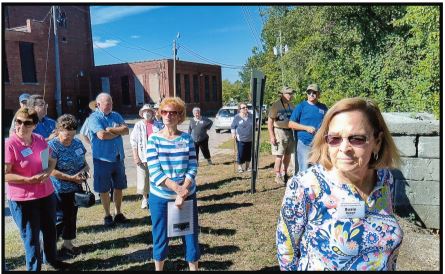
Lowell & Margaret Griffin, Margo Finney, Bill Helbing, Sue Jesse,
David Kurvach, Larry Leach, Wayne Leach, Sam & Jo Ligget,
Dr. Ron Morris, Mike Morthorst, Ed & Cynthia Powers,
Preston Richardt, Bob & Carolyn Schmidt, Tom Schmitt,
Kay Sheldon, Steve & Sue Simerman

